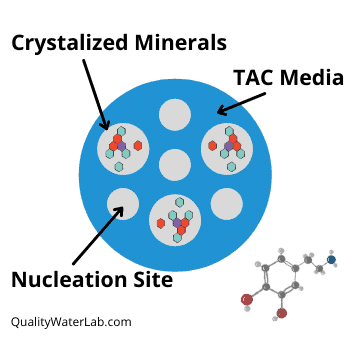If you’re looking for a salt-free way to deal with hard water, you’ve probably run into the terms TAC and NAC. They sound technical — and they are — but both refer to similar technologies that prevent minerals from forming scale in your plumbing.
These systems fall under the water conditioning category. They don’t remove minerals like traditional softeners do — they simply neutralize them, making it easier on your appliances and fixtures.
So, what’s the actual difference between TAC and NAC? And how do they compare to salt-based softeners? Let’s break it down in plain English and help you decide what’s right for your home.
⚡ Quick Takeaways
- 🌀 TAC (Template Assisted Crystallization): A salt-free water conditioning method that transforms hardness minerals into harmless crystals to prevent limescale buildup. It doesn’t remove calcium or magnesium but keeps them from sticking.
- 🧪 NAC (Nucleation Assisted Crystallization): Essentially the same technology as TAC — the terms are used interchangeably, depending on the manufacturer or research source.
- ♻️ Key Difference from Softeners: Unlike ion exchange systems, TAC/NAC conditioners don’t actually remove minerals — they just neutralize them so they don’t cling to pipes or appliances.
- ⚙️ Low Maintenance, Eco-Friendly: TAC systems don’t require salt, electricity, or drainage — and they’re ideal for homeowners in salt-restricted areas or anyone looking for a more sustainable solution.
- 🧂 Not a Cure-All: If you need to remove iron, manganese, or have very hard water, you may still need a traditional softener or specialty filter alongside a conditioner.
🧪 What Is Template-Assisted Crystallization?
If you’ve got hard water, you already know the struggle — soap that won’t lather, crusty faucets, and water heaters that wear out too soon.
That’s where TAC steps in. Short for Template-Assisted Crystallization, this tech neutralizes hard minerals like calcium and magnesium without removing them.

💡 How it works:
- TAC media is made from ceramic beads covered in “template sites.”
- These sites attract hardness minerals and convert them into tiny crystals.
- Once crystallized, they’re no longer able to stick to pipes or fixtures.
- The result? No scale buildup — and no salt, electricity, or backflushing required.
🧼 Good to Know: These crystals stay suspended in water, so they won’t bond to surfaces or form scale. Your appliances stay cleaner, longer.
❓ Do They Really Soften Water?

Not quite — but they get close enough for most homes.
🧊 Here’s the deal:
TAC systems (Template-Assisted Crystallization) are often called “salt-free water softeners,” but technically, they don’t soften water. Instead of removing minerals, they change the structure so minerals won’t stick and form limescale. It’s a big win for your plumbing — but doesn’t meet the strict definition of softening.
Let’s compare how each system works:
| System Type | What It Does | Removes Minerals? | Maintenance |
|---|---|---|---|
| 💧 Ion Exchange Softener | Replaces calcium & magnesium with sodium via resin bed | ✅ Yes | 🧂 Requires salt refills + regeneration cycles |
| 🔬 TAC Conditioner | Turns minerals into harmless crystals that don’t stick | ❌ No (minerals remain in water) | 🛠️ Virtually maintenance-free |
🧠 Pro Tip: If your water is extremely hard and causing skin issues or laundry problems, a traditional softener may still be the better fit. But if you’re just trying to stop scale and want less hassle, TAC works wonders. Learn more about how TAC works here.
🔄 Softeners vs Conditioners

If you’re deciding between a water softener and a salt-free conditioner, it helps to see how they work side-by-side. Both improve water quality — but they operate in completely different ways.
Here’s how they compare:
| System Type | How It Works | Main Purpose | Salt Required? | Removes Hardness? |
|---|---|---|---|---|
| 💧 Water Softener | Uses ion exchange to swap calcium & magnesium for sodium ions | Physically removes hardness minerals | ✔️ Yes | ✔️ Yes |
| ⚙️ Water Conditioner (TAC/NAC) | Transforms minerals into crystal form to prevent scale buildup | Prevents limescale without removing minerals | ❌ No | ❌ No |
💡 Pro Tip: Soft water helps with dry skin, soap lather, and protecting pipes. But if you want a no-maintenance, eco-friendly system that doesn’t remove healthy minerals, a conditioner might be a smarter fit.
🤔 Which One Do You Need?

Choosing between a salt-based water softener and a salt-free conditioning system like TAC comes down to your water hardness level — and your lifestyle priorities.
🧪 If your water test shows high hardness, you may need a full softener. But for most homeowners with moderate hardness, a conditioner will handle the job with less hassle.
⚖️ When To Choose Which?
- 🧂 Go with a softener if:
- Your water hardness exceeds 10 grains per gallon (GPG) or 170 PPM
- You want the classic benefits of soft water: silkier skin, no soap scum, and longer-lasting plumbing
- You don’t mind routine salt refills and higher upkeep
- ⚙️ Opt for a conditioner if:
- You want to prevent scale without removing beneficial minerals
- You’re in a drought-prone or salt-restricted area
- You prefer a low-maintenance, eco-friendly option
💡 Good to Know: Water conditioners like TAC don’t “soften” in the traditional sense — they alter hardness minerals so they won’t stick. But they won’t eliminate dry skin or boost soap lather the way a full softener does.
Still unsure where you land? Start with a water test to assess your hardness level and contaminants — you can find affordable options right here.
💰 TAC vs Softeners: Cost Breakdown

When it comes to overall cost, salt-free conditioners like TAC often win the long game. While upfront prices are similar to traditional softeners, it’s the ongoing expenses that separate the two.
- 🧂 Salt Costs Add Up Expect to spend $250–$400/year on salt refills with a conventional softener.
- 💦 Water Waste During Regeneration Softeners use 70–200 gallons per cycle to rinse out minerals — that’s extra water down the drain.
- ⚡ Electricity Use Traditional units require power to run the control valve, timers, and regeneration process.
- 🔌 TAC = Set & Forget Salt-free systems like TAC need zero electricity, no salt, and waste no water during operation.
💡 Pro Tip: Over 5–10 years, you could save hundreds (even thousands) by switching to a salt-free conditioner, especially if you live in an area with rising water or utility costs.
💚 TAC: Clean Water, Clean Conscience
TAC systems aren’t just good for your plumbing — they’re great for your lifestyle and the planet. Here’s how they stack up in terms of upkeep, eco-friendliness, and what they do (or don’t) add to your drinking water.
| 🌍 Feature | 🚿 TAC Conditioner | 🧂 Traditional Softener |
|---|---|---|
| Wastewater Output | Zero | 70–200 gal/week |
| Electricity Use | None | Yes |
| Monthly Maintenance | None | Salt refills + system checks |
| Removes Healthy Minerals? | No | Yes |
| Adds Sodium? | No | ~100mg/day |
💡 Good to Know: TAC conditioners are set-it-and-forget-it. You keep the beneficial calcium and magnesium — no salt, no fuss, no flat-tasting water. And if you’re in a drought-prone or salt-restricted region, they’re the clear winner.
⚠️ When TAC Falls Short

TAC systems shine when your main concern is preventing scale — but they don’t solve every hard water woe.
💧 If your water hardness is above 10 PPM, you may still experience:
- Dry skin or limp hair
- Soap that refuses to lather
- Spotting on dishes and fixtures
👉 In that case, a traditional water softener might serve you better — or consider combining systems for the best of both worlds.
🧪 Pro Tip: Always test your water before you buy. Knowing your hardness level and any other problem contaminants helps you choose the right tool for the job.
🧪 Is TAC Backed by Data?
Yes — and not just by anecdote.
A study from Arizona State University found that TAC systems reduced scale formation by over 90% — no salt, no electricity, and no chemical runoff.
Compare that to electronic or magnetic conditioners, which topped out at around 50% effectiveness.
🧠 Bottom line: If you’re looking for a proven salt-free way to fight scale, TAC is one of the only technologies with real data behind it.
💰 Are They Worth It?
Short answer? Absolutely — if scale prevention is your main goal.
🏠 Scale can:
- Ruin water pressure
- Destroy heating elements
- Leave a crusty mess on every fixture
💸 TAC conditioners:
- Help extend appliance life
- Improve heating efficiency
- Even dissolve some existing scale
They’re also low-maintenance, eco-friendly, and a value booster when it’s time to sell your home.
✅ Is It NSF-Certified?
Because TAC systems don’t “remove” contaminants, they’re not NSF-certified for performance like filters or softeners.
But they can be certified under NSF/ANSI Standard 61, which verifies the safety of:
- 🔗 Hoses and seals
- 🧱 Media and barrier materials
- 🔧 Valves and fittings
This means the system is made from non-toxic components — a good sign that the manufacturer stands behind its quality.
👉 Want to understand what NSF means? Read more here.
🧠 Final Take
TAC and NAC? Just two names for the same salt-free scale fighter.
But compared to traditional softeners, TAC systems offer:
- Lower cost over time
- Zero salt or electricity
- No water waste
- A cleaner, more sustainable way to protect your plumbing
🧪 Get your water tested, weigh your needs, and you’ll know exactly which path to take — softener, conditioner, or a combo of both.
 140 people found this helpful. Was this guide helpful to you?
140 people found this helpful. Was this guide helpful to you? 

